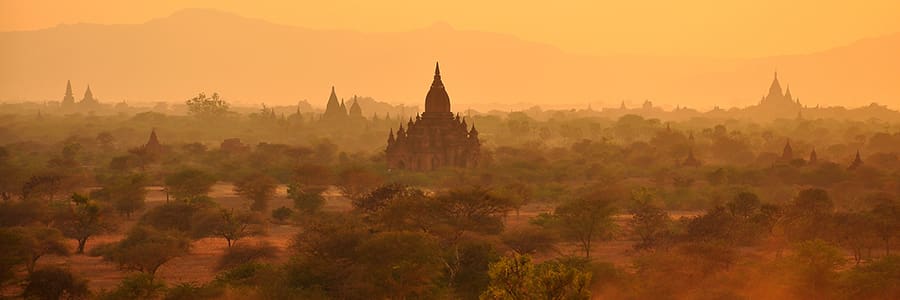
About The Irrawaddy River
The name Irrawaddy is believed to derive from the Sanskrit term “airavati,” meaning “elephant river.”
Running 1,350 miles from the Himalayas to the Indian Ocean, the Irrawaddy is Myanmar’s principal river and its commercial and spiritual heart. Kipling called it “The Road to Mandalay,” and a cruise along its serene waters rewards the traveler with a land like no other: sensual, spiritual, spellbinding.
In a place few foreigners have ever gone, the Irrawaddy offers the ideal opportunity to immerse yourself in the wonders of Myanmar, formerly known as Burma: Bagan, the country’s spiritual heart, where ancient monarchs erected more than 4,000 temples across a 20-square-mile plain, thousands of which still stand as ghostly sentinels of a mighty past; Mandalay, the former royal capital, its waterfront a picture-perfect Southeast Asian trading post; and Yangon, a magical city of gilded temples, stupas, and statues, air perfumed with incense, and monks and pilgrims chanting and making offerings of flowers and fruit.
As more and more Westerners discover its charms, there are an increasing number of cruise operators offering trips along the mighty Irrawaddy. Cruises range from short 3- and 4-day trips to longer voyages up to 11 days, with vessels ranging from ultra-luxury to traditional Burmese style.
Irrawaddy River Stats
Length: 1,373 miles
Depth: Average 30 feet
Source: Mali & N’Mai Rivers, Myanmar
Mouth: The Andaman Sea
Locks: 0
Countries: Myanmar (Burma)
Learn More About the Irrawaddy River of Asia
The Irrawaddy River, also known as the Ayeyarwady River, is one of Southeast Asia’s most iconic and significant waterways. Flowing through the heart of Myanmar (formerly known as Burma), this majestic river has played a pivotal role in the country’s history, culture, and economy for centuries. Spanning approximately 2,170 kilometers (1,348 miles), the Irrawaddy River meanders through diverse landscapes, from the snow-capped peaks of the Himalayas to the fertile plains of the Irrawaddy Delta, finally emptying into the Andaman Sea. This essay will take you on a journey through the Irrawaddy River, exploring its rich history, cultural significance, ecological importance, and the challenges it faces in the modern era.
Historical Significance
The Irrawaddy River has been a lifeline for Myanmar for thousands of years. Its history is deeply intertwined with that of the Burmese people, and its banks have witnessed the rise and fall of empires, the spread of Buddhism, and the struggles for independence. The river served as a natural trade route, facilitating the exchange of goods, ideas, and cultures between the Indian subcontinent and Southeast Asia. It was along the Irrawaddy that the ancient city of Pagan (modern-day Bagan) flourished as a center of Buddhist art and scholarship, leaving behind thousands of temples and pagodas that still stand today. During the colonial period, the Irrawaddy River played a significant role in British Burma’s administration and economy. Steamships plied its waters, connecting remote regions and ensuring the efficient transportation of goods. However, this period also witnessed the exploitation of Myanmar’s resources and people, leading to economic disparities that persist to this day.
Cultural Significance
The Irrawaddy River is not only a historical treasure but also a cultural one. The river is mentioned in countless Burmese poems, songs, and legends, reflecting its profound importance in the collective consciousness of the people. River cruises along the Irrawaddy are a popular way for tourists to explore Myanmar, allowing them to immerse themselves in the country’s culture while enjoying stunning natural scenery. The river’s banks are dotted with picturesque villages where traditional ways of life persist. Fishing communities rely on the river’s abundant fish stocks, and agriculture thrives in the fertile plains irrigated by its waters. The Irrawaddy also hosts various annual festivals and celebrations, such as the Phaung Daw Oo Pagoda Festival, which draws pilgrims and tourists alike.
Ecological Importance
The Irrawaddy River is not only a cultural and historical treasure but also an ecological one. It flows through a range of ecosystems, from mountainous headwaters to the lush wetlands of the Irrawaddy Delta. This diverse habitat supports a wide variety of wildlife, including endangered species like the Irrawaddy dolphin and the Burmese roofed turtle. The Irrawaddy Delta, often referred to as the “rice bowl” of Myanmar, is one of the world’s most fertile regions, thanks to the river’s annual flooding. Rice, shrimp, and fish production in the delta are crucial to Myanmar’s food security and export industry. However, this fragile ecosystem faces threats from deforestation, pollution, and climate change, which can lead to devastating consequences for both nature and people.
Modern Challenges
While the Irrawaddy River remains a vital resource for Myanmar, it is not without its modern challenges. Infrastructure development, such as dams and bridges, can alter the river’s flow and impact the communities that rely on it. Pollution from urban centers and industrial activities threatens water quality, endangering aquatic life and the health of people who depend on the river for drinking water and agriculture. Furthermore, the political and social landscape in Myanmar has been marked by periods of instability and conflict, affecting the management and conservation of the Irrawaddy River. Sustainable practices and responsible governance are needed to address these challenges and ensure the river’s continued vitality.
